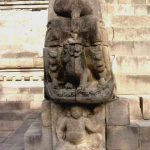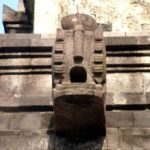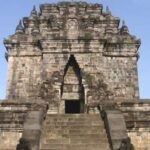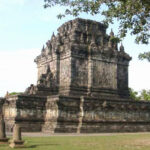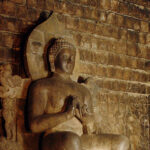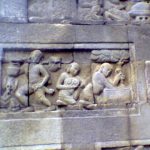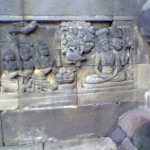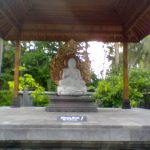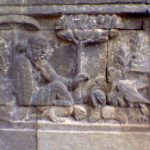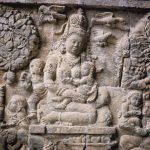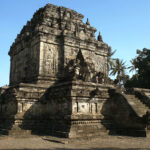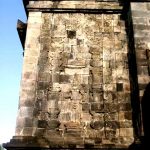Mendut
Mendut
Built around early ninth century AD, Mendut is the oldest of the three temples including Pawon and Borobudur. The Karangtengah inscription, the temple was built and finished during the reign of King Indra of Sailendra dynasty. The inscription dated 824 AD mentioned that King Indra of Sailendra has built a sacred building named Venuvana which means “bamboo forest”. Dutch archaeologist JG de Casparis has connected the temple mentioned in Karangtengah inscription with Mendut temple.
In 1836 it was discovered as a ruins covered with bushes. The restoration of this temple was started in 1897 and was finished in 1925. Some archaeologists who had conducted research on this temple were JG de Casparis, Theodoor van Erp [nl], and Arisatya Yogaswara.
 Architecture
Architecture
The plan of temple’s base is square, and measures 13.7 metre on each side, with the base level 3.7 metre above the ground . The 26.4 metre tall temple is facing northwest. The stairs projecting from the northwest side square elevated base is adorned with Makara statue on each sides, the side of the stairwall carved with bas-relief of Jataka fable narrating the animal story of Buddhist teaching.
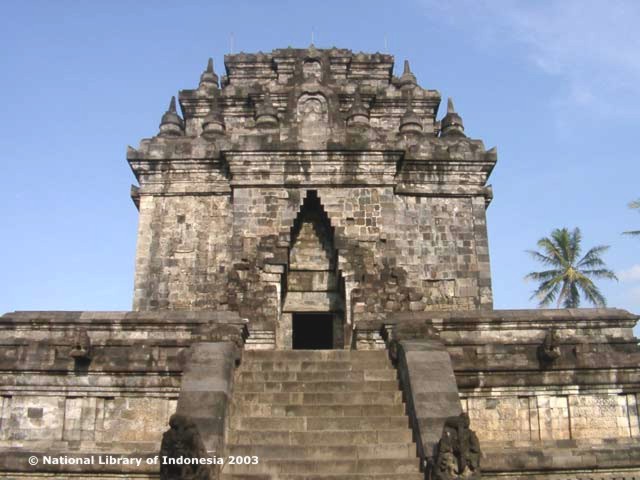 The square terrace surrounding the body of the temple was meant for pradakshina or circumambulating ritual, walking clockwise around the temple. The outer walls is adorned with bas-reliefs of Boddhisattvas (Buddhist divinities), such as Avalokitesvara, Maitreya, Cunda, Ksitigarbha, Samantabhadra, Mahakarunika Avalokitesvara, Vajrapani, Manjusri, Akasagarbha, and Boddhisattvadevi Prajnaparamita among other buddhist figures.
The square terrace surrounding the body of the temple was meant for pradakshina or circumambulating ritual, walking clockwise around the temple. The outer walls is adorned with bas-reliefs of Boddhisattvas (Buddhist divinities), such as Avalokitesvara, Maitreya, Cunda, Ksitigarbha, Samantabhadra, Mahakarunika Avalokitesvara, Vajrapani, Manjusri, Akasagarbha, and Boddhisattvadevi Prajnaparamita among other buddhist figures.
Originally the temple had two chambers, a small chamber in the front, and the large main chamber in the center. The roof and some parts of the front chamber walls are missing. The uppermost part of the roof is missing, it supposed to have a stupa pinnacle with size and style probably just like the one in Sojiwan temple.
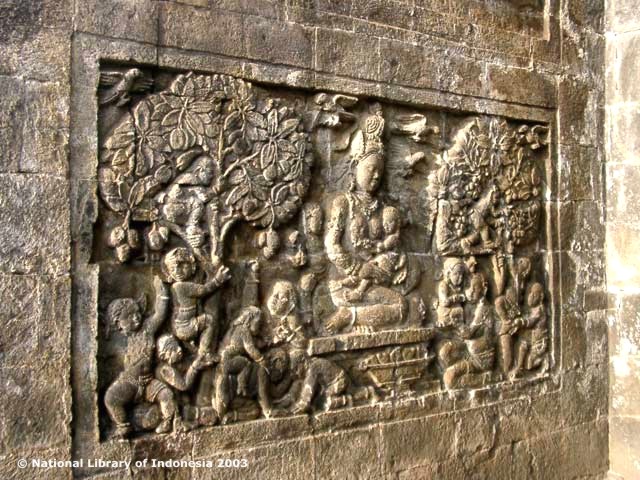 The inner wall of front chamber is adorned with bas-relief of Hariti surrounds by children, Atavaka on the other side, Kalpataru, also groups of devatas divinities flying in heaven.
Location three Buddhist temples, Borobudur-Pawon-Mendut, in one straight line across Progo River.
The inner wall of front chamber is adorned with bas-relief of Hariti surrounds by children, Atavaka on the other side, Kalpataru, also groups of devatas divinities flying in heaven.
Location three Buddhist temples, Borobudur-Pawon-Mendut, in one straight line across Progo River.
The main room has three carved large stone statues. The 3 metres tall statue of Dhyani Buddha Vairocana was meant to liberate the devotees from the bodily karma, at the left is statue of Boddhisatva Avalokitesvara to liberate from the karma of speech, at the right is Boddhisatva Vajrapani to liberate from karma of thought.
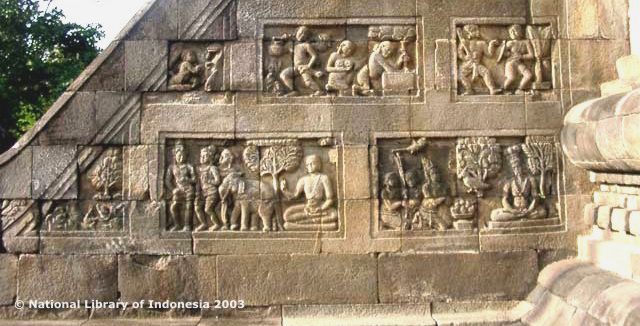 Rituals
Rituals
During full moon in May or June, Buddhists in Indonesia observe the annual Vesak ritual by walking from Mendut through Pawon to Borobudur. The ritual takes the form of a mass Buddhist prayer and pradakshina (circumambulation) around the temple.
To followers of traditional Kejawen (Javanese mysticism) or Buddhism, praying in the Mendut temple is believed to fulfill wishes, such as deliverance from sickness. Childless couples, for example, pray at the bas-relief of Hariti for a child, since in traditional Javanese beliefs, Hariti is a symbol of fertility, patroness of motherhood and protector of children.
 Some spots along the walkway’s outer wall have jaladwara or water channel to drain water from the walkway. Jaladwara is common to most temples in Central Java and Yogyakarta, such as Borobudur, Banyuniba, Prambanan and Ratu Baka. While retaining its artistic nature, jaladwara varies in design from one temple to the other.
Some spots along the walkway’s outer wall have jaladwara or water channel to drain water from the walkway. Jaladwara is common to most temples in Central Java and Yogyakarta, such as Borobudur, Banyuniba, Prambanan and Ratu Baka. While retaining its artistic nature, jaladwara varies in design from one temple to the other.
 Stairs to the walkway are placed on the west side, right in front of the door into the temple’s interior. The door has a projecting corbelled roof as high as the roof of the temple and has neither gate nor frame.
Stairs to the walkway are placed on the west side, right in front of the door into the temple’s interior. The door has a projecting corbelled roof as high as the roof of the temple and has neither gate nor frame.
The stairs’ banisters are embellished with sculptured panels describing stories of Buddhist teaching. The bottom end of each banister holds a dragon head with mouth wide open, carrying a statue of lion inside. Under the dragon head, there is a panel carrying relief of a dwarf that looks like a Gana.
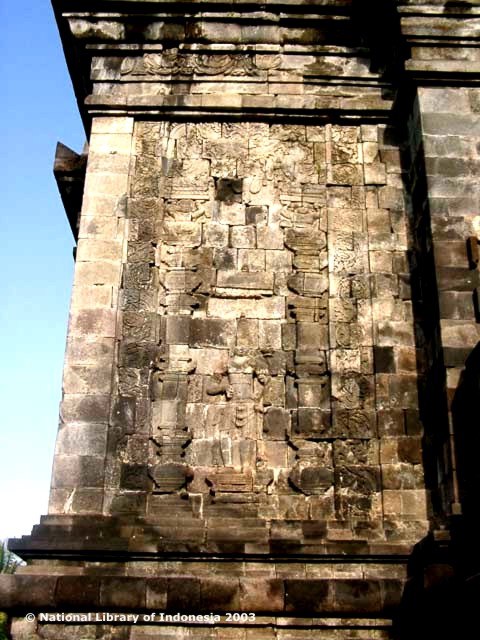 The temple’s roof comprises three cubes arranged in ever-decreasing size to the top, similar to that of the temples in Dieng and Gedongsanga. The cubes are encircled by 48 small stupas. The roof’s top has crumbled, which makes it not possible to describe the original form.
The temple’s roof comprises three cubes arranged in ever-decreasing size to the top, similar to that of the temples in Dieng and Gedongsanga. The cubes are encircled by 48 small stupas. The roof’s top has crumbled, which makes it not possible to describe the original form.
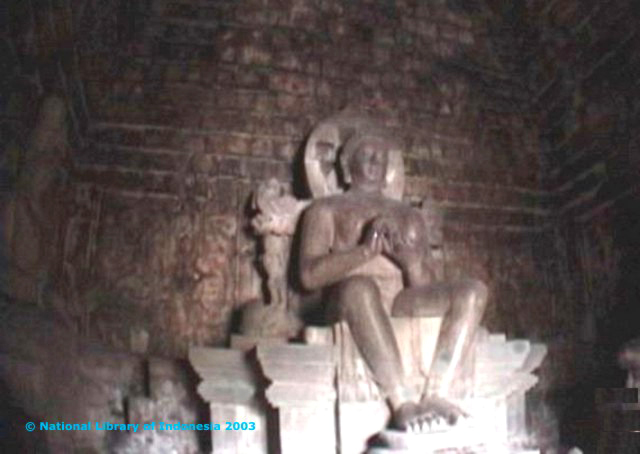 The wall in the corbelled roof’s interior is adorned with relief of Kuwera or Avataka on the north and Hariti on the south. Kuwera is a man-eating giant who repents after seeing the Buddha.
The wall in the corbelled roof’s interior is adorned with relief of Kuwera or Avataka on the north and Hariti on the south. Kuwera is a man-eating giant who repents after seeing the Buddha.
The giant changed into god of fortune and guardian of children. Kuwera is married to Hariti, who also used to be a man-eating giant. As her husband does, Hariti repents after seeing the Buddha and becomes a guardian of children.
This relief of Kuwera and Hariti is found in most temples of Tantrayana Buddhism such as Sewu, Banyuniba and Kalasan. In the relief Kuwera is depicted sitting on a bench among children at play. Under the bench, there is a money pouch. Money pouch is characteristic of Kuwera as the god of fortune. Hariti relief portrays identical atmosphere. Hariti is sitting on a bench with a child on her lap among children at play.
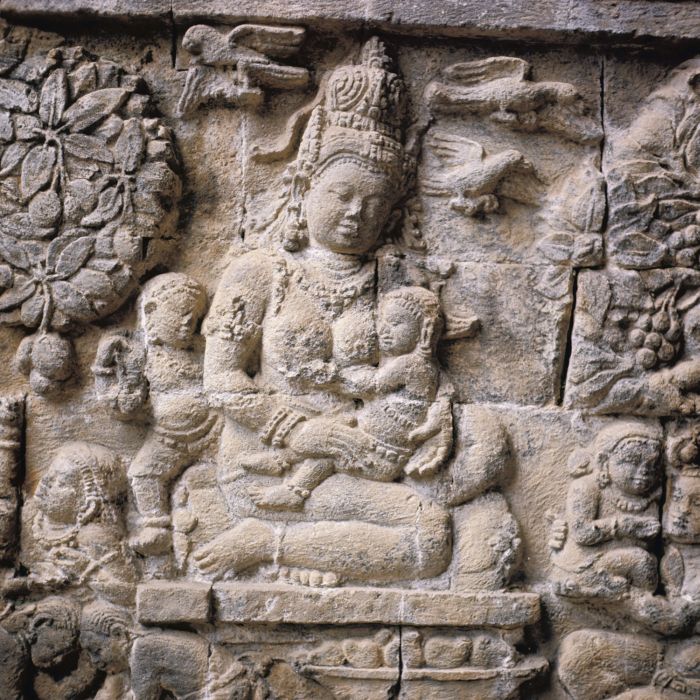
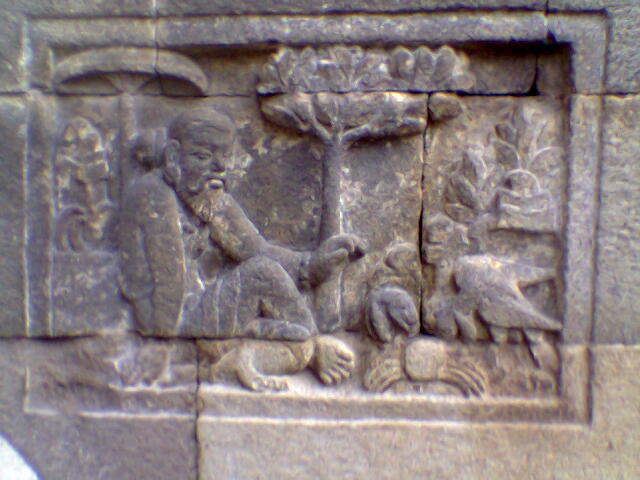 The temple’s body carries relief friezes depicting the life of Buddha. The southern wall is adorned with relief of Bodhisattva Avalokitesvara, depicting the Buddha sitting on lotus throne under the shade of kalpataru tree. To his right is Dewi Tara sitting on lotus throne and to his left is another woman who is also sitting on lotus throne.
The temple’s body carries relief friezes depicting the life of Buddha. The southern wall is adorned with relief of Bodhisattva Avalokitesvara, depicting the Buddha sitting on lotus throne under the shade of kalpataru tree. To his right is Dewi Tara sitting on lotus throne and to his left is another woman who is also sitting on lotus throne.
Two clouds hang over them, each with a figure of man reading a book. To their left and right sides, there are stone pillars with a dwarf on top bearing something. Buddha is facing a pool full of lotus flowers. The pool’s water comes from teardrops of the Buddha who is sad to think of the miseries of human beings in the world. Two women are depicted to appear amid lotuses in the pool.
 The eastern wall carries relief sculpture of Bodhisattva, depicting the Buddha as a figure with four arms standing on an object that looks like a linga. He is wearing imperial clothes and his head emanates rays of divine light. A book is on his rear left hand, prayer beads on his rear right hand, while the two front hands are in varamudra or blessing position. To his left, there is a jug containing a lotus flower.
The eastern wall carries relief sculpture of Bodhisattva, depicting the Buddha as a figure with four arms standing on an object that looks like a linga. He is wearing imperial clothes and his head emanates rays of divine light. A book is on his rear left hand, prayer beads on his rear right hand, while the two front hands are in varamudra or blessing position. To his left, there is a jug containing a lotus flower.
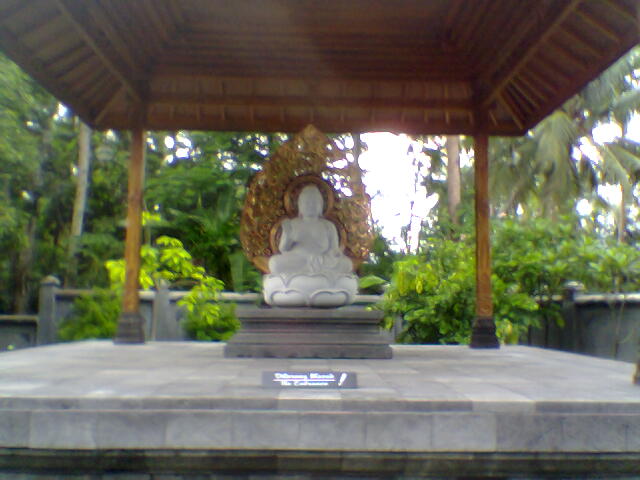 The northern wall is embellished with relief sculpture depicting Dewi Tara sitting on lotus throne flanked by two men. Tara is described in this sculpture as a goddess with eight arms. The four left hands hold an oyster, wajra, cakra, and prayer beads, while the four right hands hold a saucer, axe, stick, and book.
The northern wall is embellished with relief sculpture depicting Dewi Tara sitting on lotus throne flanked by two men. Tara is described in this sculpture as a goddess with eight arms. The four left hands hold an oyster, wajra, cakra, and prayer beads, while the four right hands hold a saucer, axe, stick, and book.
The west or front wall carries relief sculpture of Sarwani-warana-wiskhambi standing under an umbrella wearing imperial clothes.
The relatively wide interior of Mendut temple has three statues of Buddha. Facing the door is Buddha Sakyamuni, or the teaching Buddha. Buddha is depicted sitting with hands in dharmacakramudra or teaching position.
To the right is the statue of Bodhisattva Avalokiteswara or the helping Buddha. Buddha is depicted sitting with left leg bended and right leg hanging down. His right foot steps on a small lotus pad. To the left and facing north is the statue of Maitreya, or liberating Bodhisattva who is sitting with hands in simhakarnamudra position, which looks like vitarkamudra position except that the fingers are clasped. The head of each statue emanates prabha or divine rays of light.


